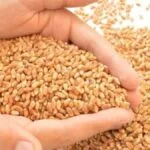Main Points In Hindi (मुख्य बातें – हिंदी में)
यहाँ पर दिए गए टेक्स्ट के मुख्य बिंदु निम्नलिखित हैं:
-
गेहूं की बुवाई का उचित समय: गेहूं की बुवाई के लिए सामान्यतः नवंबर को उचित माना जाता है, लेकिन खरीफ फसल के कटाई के बाद दिसंबर में भी बुवाई की जा सकती है।
-
मृदा की गुणवत्ता: गेहूं की खेती के लिए लून और सैंड लून मृदा सबसे अच्छी मानी जाती है, क्योंकि यह नमी को बनाए रखने के साथ-साथ मृदा की उर्वरता को भी बढ़ाती है।
-
उच्च गुणवत्ता वाली किस्में: भारतीय कृषि अनुसंधान परिषद द्वारा विकसित उच्च गुणवत्ता वाली गेहूं की किस्में न केवल उत्पादन में वृद्धि करती हैं, बल्कि फसल की रोग प्रतिरोधकता को भी बढ़ाती हैं।
-
जलवायु के अनुकूल किस्में: ICAR द्वारा विकसित गेहूं की कुछ प्रजातियाँ विशेष रूप से बदलते जलवायु की चुनौतियों का सामना करने के लिए तैयार की गई हैं, ताकि किसान लाभान्वित हो सकें।
- विभिन्न गेहूं की किस्में और उनकी विशेषताएँ: जैसे कि HD 3226 (Pusa Yashasvi) जिसे रोगों के प्रति उच्च प्रतिरोधकता और अधिक उपज (30-32 क्यूंटल प्रति एकड़) के लिए जाना जाता है, और DBW 187 (Karan Vandana) जो विशेष रूप से उत्तर-पूर्वी भारत के लिए विकसित की गई है।
इन बिंदुओं से यह स्पष्ट होता है कि गेहूं की बुवाई का सही समय, मिट्टी की गुणवत्ता और उचित किस्मों का चयन फसल की उपज और किसान की आय में महत्वपूर्ण भूमिका निभाते हैं।


Main Points In English(मुख्य बातें – अंग्रेज़ी में)
Here are the main points summarized from the provided text about wheat cultivation and improved varieties:
-
Optimal Sowing Time: The ideal time for sowing wheat is generally in November, with an option to sow in December after the Kharif crop is harvested. Timely sowing and selecting the right variety are crucial for achieving good yields.
-
Soil Type for Wheat Cultivation: Loamy and sandy loam soils are considered best for wheat farming as they retain moisture and enhance soil fertility, which is important for successful wheat cultivation.
-
Improved Wheat Varieties: The Indian Council of Agricultural Research (ICAR) has developed several high-yield and disease-resistant wheat varieties tailored for different climatic conditions across various regions of India. Some notable varieties include:
- HD 3226 (Pusa Yashasvi): Resistant to multiple diseases and can yield 30-32 quintals per acre when sown at optimal times.
- DBW 187 (Karan Vandana): Suitable for northeastern plains, resistant to leaf blight, yielding about 25 quintals per acre.
- HD 2967: A widely adapted variety with a yield of 22-23 quintals per acre and resistance to yellow rust, best sown in early November.
- HD 3086 (Pusa Gautami): Suitable for irrigated areas, yielding 22-23 quintals per acre, resistant to yellow and brown rust diseases.
- HD CSW 18: Yields 25-26 quintals per acre, resistant to yellow rust and adaptable to high temperatures.
-
Benefits of Improved Varieties: Utilizing these improved wheat varieties can significantly enhance yields, increase disease resistance, and provide better income for farmers, especially in the face of changing climatic conditions.
- Regional Adaptation: The improved wheat varieties are specifically designed to thrive in various regions of India, ensuring that farmers can maximize production while being protected from climate change impacts.
Complete News In Hindi(पूरी खबर – हिंदी में)
गेंहू बोने का सही समय सामान्यतः नवंबर माना जाता है, लेकिन खरीफ फसल की कटाई के बाद गेंहू दिसंबर में भी बोया जा सकता है। गेंहू की खेती के लिए लोमी और बालू-लोमी मिट्टी सबसे अच्छी होती है, क्योंकि यह न केवल नमी को बनाए रखती है, बल्कि मिट्टी की उर्वरता भी बढ़ाती है। सही किस्म और समय पर बुवाई अच्छे उत्पादन के लिए बहुत महत्वपूर्ण है। बेहतर किस्में न केवल उपज बढ़ाती हैं, बल्कि फसल की बीमारी का प्रतिरोध भी बढ़ाती हैं। यदि आप इस रबी सीजन में उच्च गुणवत्ता वाली गेंहू की किस्में चुनते हैं, तो आपकी उपज में काफी सुधार हो सकता है। ये किस्में भारतीय कृषि अनुसंधान परिषद द्वारा विकसित की गई हैं और ये सभी प्रकार के मौसम में उच्च उत्पादन देती हैं।
ये गेंहू की किस्में देंगे अच्छी उपज
भारतीय कृषि अनुसंधान परिषद (ICAR) के संस्थानों ने बदलते जलवायु परिस्थितियों को ध्यान में रखते हुए कुछ बेहतरीन गेंहू की किस्में विकसित की हैं, जो किसानों को बदलते मौसम की चुनौतियों के बावजूद उच्चतम उपज देने में सक्षम हैं। ये किस्में विभिन्न क्षेत्रों में उगाने के लिए विशेष रूप से डिज़ाइन की गई हैं, ताकि किसानों को जलवायु परिवर्तन के प्रभावों से बचाया जा सके और उनकी आय बढ़ाई जा सके। यदि किसान नवंबर में इन 5 किस्मों को बोते हैं, तो उन्हें बेहतरीन उपज मिल सकती है।
HD 3226 (Pusa Yashasvi)
HD 3226, जिसे Pusa Yashasvi भी कहा जाता है, भारतीय कृषि अनुसंधान संस्थान, पूसा द्वारा विकसित एक उन्नत गेंहू की किस्म है। यह किस्म पीले, भूरे और काले रस्ट जैसी बीमारियों के प्रति अत्यधिक प्रतिरोधी है। इसकी खेती से प्रति एकड़ 30-32 क्विंटल उत्पादन प्राप्त किया जा सकता है। इसकी बुवाई का सर्वोत्तम समय 5 से 25 नवंबर के बीच है। अधिकतम उपज के लिए, इसे अक्टूबर के दूसरे पखवाड़े में बोना फायदेमंद है। इसे पंजाब, हरियाणा, दिल्ली, राजस्थान, पश्चिमी उत्तर प्रदेश, जम्मू और कश्मीर में सफलता से उगाया जा सकता है। सही समय पर बोईं जाने वाली यह किस्म किसानों को अधिक लाभ दे सकती है।
DBW 187 (Karan Vandana)
DBW 187 यानी Karan Vandana एक नई और उन्नत गेंहू की किस्म है, जिसे 2019 में जारी किया गया था। यह किस्म विशेष रूप से उत्तर-पूर्वी भारत के मैदानी क्षेत्रों जैसे पूर्वी उत्तर प्रदेश, बिहार, झारखंड, असम और पश्चिम बंगाल के उत्तर-पूर्वी हिस्सों के लिए विकसित की गई है। Karan Vandana किस्म पत्ते की धुंध जैसी बीमारियों के प्रति बेहतर प्रतिरोधी है। यह किस्म 77 दिनों में फूलती है और 120 दिनों में पकती है। इसकी औसत ऊँचाई 100 सेंटीमीटर है और इसकी उपज प्रति एकड़ 25 क्विंटल है।
और पढ़ें: लंबा नमक: थार शीतल ककड़ी की सबसे अच्छी किस्म है, इसे ऑफ़ सीजन में भी उगाया जा सकता है।
HD 2967 गेंहू की किस्म
HD 2967 एक उच्च अनुकूलित और उत्कृष्ट गेंहू की किस्म है, जो पूरे भारत में लोकप्रिय है। इसकी फसल लगभग 150 दिनों में तैयार हो जाती है और प्रति एकड़ 22-23 क्विंटल उत्पादन देती है। यह पीले रस्ट रोग के प्रति प्रतिरोधी है। यह किस्म पंजाब, हरियाणा, दिल्ली, उत्तर प्रदेश और राजस्थान (कुछ क्षेत्रों को छोड़कर) में सफलतापूर्वक उगाई जा सकती है। विशेषज्ञों के अनुसार, जल्दी बोने का सही समय 1 से 15 नवंबर है, जो उपज पर सकारात्मक प्रभाव डालता है।
HD 3086 (Pusa Gautami)
Pusa Gautami HD 3086 एक गेंहू की किस्म है, जिसे समय पर बुवाई और सिंचाई वाले क्षेत्रों के लिए विशेष रूप से उपयुक्त माना जाता है। यह किस्म उत्तर-पश्चिमी मैदानों में 145 दिनों में पकती है, जबकि उत्तर-पूर्वी मैदानों में केवल 121 दिनों में पकती है। इसकी औसत उपज 22-23 क्विंटल प्रति एकड़ है। इसकी सबसे खास बात यह है कि यह पीले और भूरे रस्ट रोगों के प्रति प्रतिरोधी है, जिससे इन बीमारियों का प्रभाव कम हो जाता है। 204 बीज कंपनियों को इस किस्म के बीज की मांग के लिए लाइसेंस मिल चुका है।
HD CSW 18
HD CSW 18 की उपज 25 से 26 क्विंटल प्रति एकड़ है। यह पीले रस्ट रोग के प्रति प्रतिरोधी है और 150 दिनों में पकती है। यह किस्म गर्मी की लहर और उच्च तापमान में भूरे रस्ट रोग के प्रति भी प्रतिरोधी है। इस किस्म की बुवाई 15 नवंबर तक करनी चाहिए और पौधे की औसत ऊँचाई 110 सेंटीमीटर होती है।
इन गेंहू की किस्मों को अपनाकर, किसान बदलती जलवायु परिस्थितियों में भी अधिक उपज प्राप्त कर सकते हैं। यदि किसान इन किस्मों को नवंबर में बोते हैं, तो उन्हें शुक्रवार में अच्छे परिणाम और बेहतर आय मिल सकती है।
Complete News In English(पूरी खबर – अंग्रेज़ी में)


The appropriate time for sowing wheat is generally considered to be November, but after harvesting of Kharif crop, wheat can be sown in December also. Loamy and sandy loam soil is best for wheat cultivation, because along with retaining moisture, it also increases the fertility of the soil. Right variety and timely sowing is very important for good yield. Better varieties not only increase the yield, but also increase the disease resistance of the crop. If you choose high quality wheat varieties this Rabi season, there can be a big improvement in your yield. These varieties developed by the Indian Council of Agricultural Research not only give higher production, but there is also no difference in yield in all types of weather.
These varieties of wheat will give bumper yield
Indian Council of Agricultural Research (ICAR) institutes have developed some of the best wheat varieties keeping in mind the changing climatic conditions, which are capable of giving highest yields to the farmers despite the challenges of changing weather. These varieties have been specially designed to be grown in different regions of India, so that farmers can be protected from the effects of climate change and their income can be increased. If farmers sow these 5 varieties in November, they can get excellent yields.
HD 3226 (Pusa Yashasvi)
HD 3226 also known as Pusa Yashasvi is an improved wheat variety developed by the Indian Agricultural Research Institute, Pusa. This variety is highly resistant to diseases like yellow, brown and black rust. Through its cultivation, production up to 30-32 quintals per acre can be achieved. The best time for its sowing is between 5th to 25th November. For maximum yield, it is beneficial to sow in the second fortnight of October. It can be grown successfully in Punjab, Haryana, Delhi, Rajasthan, Western Uttar Pradesh, Jammu and Kashmir. Farmers can get maximum profits by sowing and taking care at the right time.
DBW 187 (Karan Vandana)
DBW 187 i.e. Karan Vandana is a new and improved variety of wheat, which was released in 2019. This variety has been developed specifically for the plains of north-eastern India, such as eastern Uttar Pradesh, Bihar, Jharkhand, Assam and north-eastern parts of West Bengal. Karan Vandana variety is better resistant to diseases like leaf blight. This variety flowers in 77 days and becomes ripe in 120 days. Its average height is 100 centimeters. Its yield is 25 quintals per acre.
Also read:- Longmelon: Thar Sheetal is the best variety of cucumber, can be cultivated even in off season.
HD 2967 wheat variety
HD 2967 is a highly adapted and superior variety of wheat, which is popular all over India. Its crop is ready in about 150 days and gives a production of 22-23 quintals per acre. It is resistant to yellow rust disease. This variety can be successfully cultivated in Punjab, Haryana, Delhi, Uttar Pradesh and Rajasthan (except some areas). According to experts, the appropriate time for early sowing is between 1 to 15 November, which has a positive effect on the yield.
HD 3086 (Pusa Gautami)
Pusa Gautami HD 3086 is a wheat variety considered especially suitable for timely sowing and irrigated areas. This variety becomes ripe in 145 days in the north-western plains, whereas in the north-eastern plains it takes only 121 days to ripen. The average yield is 22-23 quintals per acre. Its most special thing is that it is resistant to yellow and brown rust diseases, which reduces the effect of these diseases. 204 seed companies have got license for the demand of this variety of seeds.
hd csw 18
The yield of HD CSW 18 is 25 to 26 quintals per acre. It is resistant to yellow rust disease and becomes ripe in 150 days. This variety is also resistant to heat wave and brown rust disease in high temperatures. Sowing of this variety should be done by 15th November and the average height of the plant is 110 centimeters.
By adopting these wheat varieties, farmers can get higher yields even in changing climatic conditions. If farmers sow these varieties in November, they can get good yield and better income despite being affected by climatic fluctuations.


 By
By 





